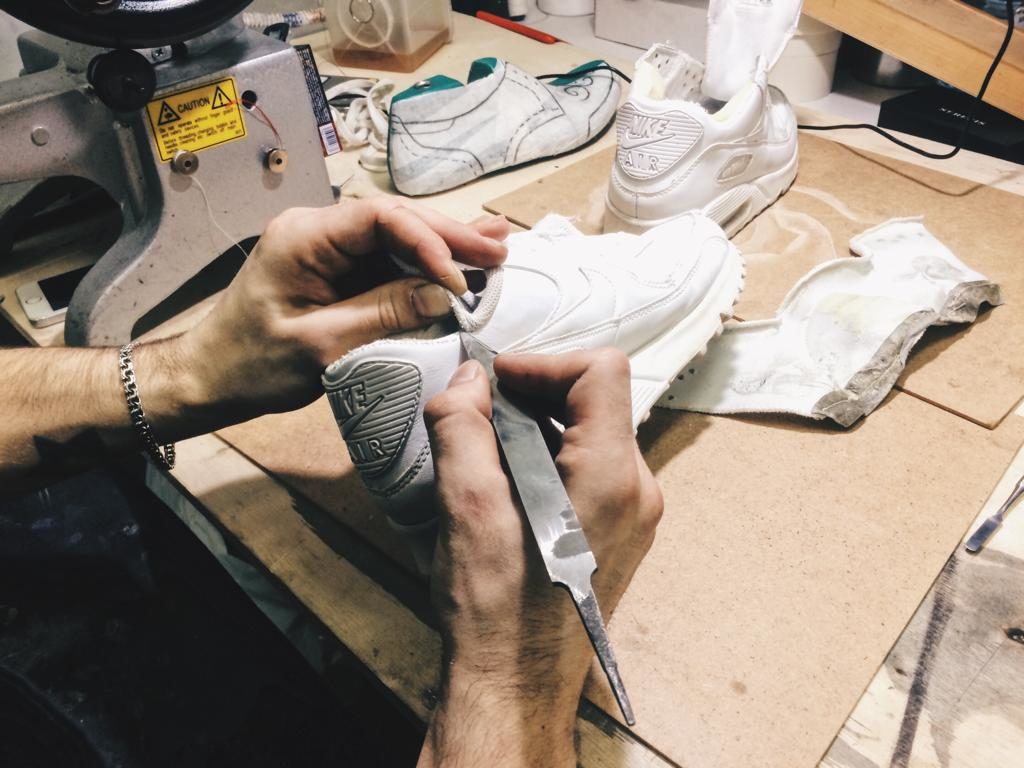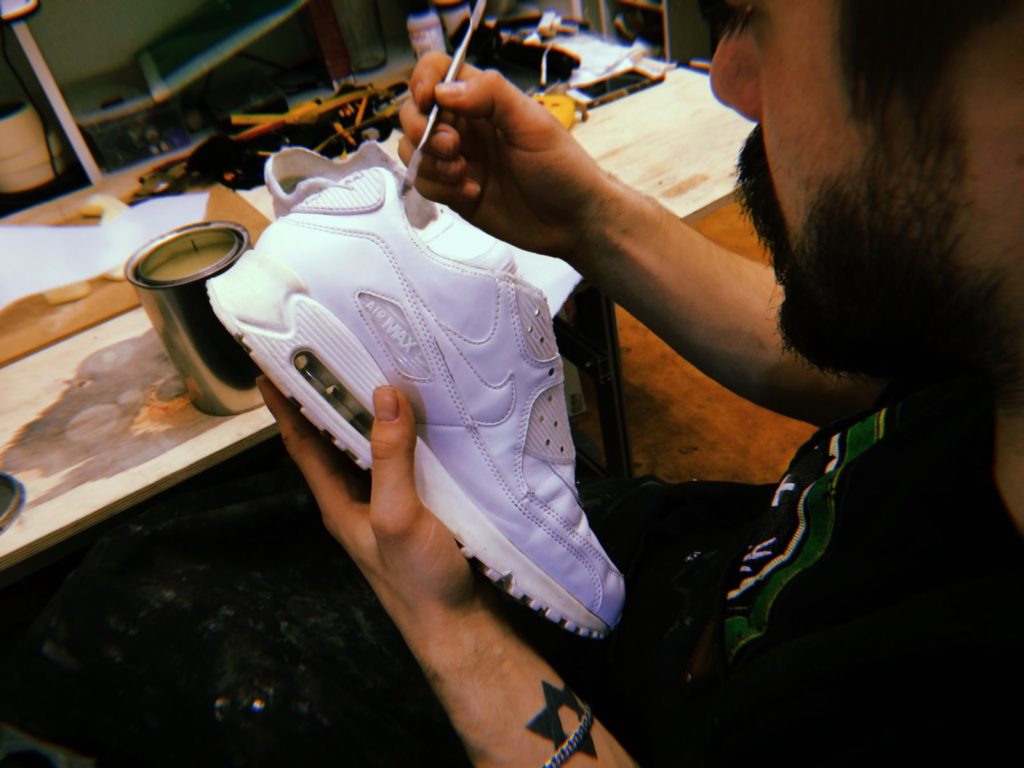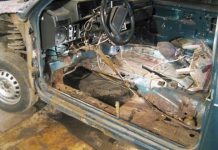In detail: do-it-yourself sneaker mesh repair from a real master for the site my.housecope.com.
Sneakers are worn by almost everyone today, although only a few use them for their intended purpose as sports shoes. And if they need to be repaired, professional shoemakers are reluctant to repair sneakers, I know this from my own experience. Or they don’t do it at all. So I want to offer some tips for repairing sneakers.
(fig. 1) The most common wear is the heel protectors. To repair them, you need a piece of hard rubber from the soles of old shoes or a rubber mat, glue "Moment", "Contactol", "88", "Butex" or "Rapid". Now there are good foreign-made "super" adhesives on the market.
Of the tools, a sharp knife is needed, preferably a boot knife, coarse-grained sandpaper or a grater made from a piece of tin from a can with holes punched in it.
The repair is done as follows. First, cut a patch out of a piece of hard rubber and fit it into place. Use a knife and a float to give the patch (Fig. 2) a wedge-shaped shape. The surfaces to be glued must be rough, for which they must be treated with sandpaper, and then wiped with a solvent and dried. Then glue is applied to the surface in two layers. Dry the glue well. The drying time of the first layer is 20 minutes, the second - at least 2-3 hours, and preferably at least 6-8 hours. After that, the surfaces to be glued must be heated over an electric stove or gas stove until the smell of glue appears, quickly attach to each other, press firmly and hold for a few seconds until it cools completely.
The sneaker can be worn immediately after being refurbished. But it’s better to wait one day.
| Video (click to play). |
(fig. 3) Repairing the heel of a shoe is more difficult. If the protector is thoroughly worn out, it is carefully torn off from the sole, cutting it in those places where it is impossible to tear it off. You can moisten such places with solvent so that the protector comes off.
The contour of the sole is transferred to cardboard, completing the erased edges, and a pattern is cut out.
A new protector can be made from a rubber mat that is still found in hardware stores.
The main thing: when gluing, thoroughly clean the surfaces to be glued, but otherwise the gluing technology is the same as above.
(fig. 4) If the soft sole has worn down, then before gluing a new tread, the soft sole is built up to the required thickness using microporous rubber.
(fig. 5) When repairing the upper of a sneaker, a lot depends on its material. If the top is made of natural, artificial leather or suede, then it cracks at the folds, or wipes.
On cracked and burst places, patches made of thinner than the top and more elastic material, for example, suede, artificial leather, are glued or sewn on.
But it is better to avoid cracking. To do this, natural leather is smeared with shoe cream, suede is cleaned with a dry stiff brush and a school washing eraser, trying to raise the pile.
To clean genuine leather and suede from dirt, it is better to use a slightly damp cloth and never wash them with water. By the way, try not to wear artificial leather shoes at sub-zero temperatures.
(Fig. 6) When the threads holding the parts of the sneakers are torn, the thread layer is restored using the old holes. You can use paper clips to pull the thread, but it is better to use a needle from a syringe, slightly dulling the tip and sharp edges on the emery so that the needle does not cut through the thread and the top.
(fig. 7) Quite often the leather of the upper cracks at the fold where the upper meets the sole. To eliminate the crack, in this place the sole is carefully trimmed and folded back (Fig.8), a piece of suede is applied to the gap or crack with a pile outward and glued using the technology described above. You can also sew on a patch.
(Fig. 9) If the top is a combination of synthetic fabric with a foam pad or natural and artificial suede, then most often the fabric in the toe is torn in the places where it touches the toes. In this case, if the hole is small, you can put a small patch (Fig. 10), and if you can see the whole leg in the hole, you need to rip up the seams, fit a piece of strong nylon fabric in place and sew as described above. The seams indicated in Figure 11 with a bold dotted line are paired and patches are applied and sewn over them (Fig. 12, 13).
I am glad to welcome you to my channel.
My group Vkontakte
Hello. Please write what is the grid? What is the correct name?
Dear Victor, is there paint for such meshes? My air max is bad, can I repaint it?
Very informative,. + Ukraine. Like :)
Well done, the only one who did it right, otherwise he glanced at the others, all some patches are sculpted. Please tell me, but how to strengthen the mesh on the backdrop inside, it has not made a hole yet, but this is a problem often on all sneakers. Can you just glue such a mesh on this place (without ripping anything, otherwise not everyone can do that)? or can you do something better?
You can glue the skin on the "dismakol" glue. Better, of course, to sew.
How to properly care for sneakers, why paint the soles and why winter is terrible for Nike - said Vladimir Pavlovsky, the owner of the SNEAKERHEAL sneaker repair shop.
Vladimir, why sneakers?
By specialty I am a technologist of shoe production, graduated from the Moscow University of Design and Technology. While studying, I got carried away with restoration and participated in the GutFab project - cleaning shoes in an armchair. Our points were in Moscow, Voronezh, Samara, St. Petersburg. When I finished my studies, I went to work at the BARKER shoe repair shop. Then the culture of sneakers began to "make its way" to Russia and the classics for me began to fade into the background. I chose the sneaker because it has an interesting design, a variety of materials and technologies. We can say that the niche is still not occupied. Many did not understand why I was doing this, because sneakers are cheaper than classics and usually no one repairs them. They wear out faster and it is easier to buy new ones.
Yes, repairs are not cheap in principle. If sports shoes are being repaired precisely in order to continue playing sports, it makes sense to hem, glue something on. But the main focus of the workshop is still an aesthetic restoration of sneakers. The repair should not only fix the problem of wearing the shoe. It should not violate the design, or even complement the appearance of the sneaker. We are trying to follow this motto!
What brands are most often brought?
The most popular are New Balance, adidas, Nike, Reebok, Saucony. I don’t remember that Demix was brought: their repair is unprofitable due to the low price of sneakers. The average bill for painting or dry cleaning is 2,000 rubles. If the sneakers cost five thousand rubles, then they should not be repaired. If the cost of repairs is no more than a third of the cost of a shoe, then it makes sense. New Balance and other sneakers are often brought in, the price tag of which starts at $ 10,000. It's a pity to throw these sneakers away.
What are the most reliable models?
It's hard to talk about a specific brand. I would classify according to the materials used. The most durable running shoes are made from leather and suede. Winter models are more durable because the package of materials is calculated for an aggressive environment: low temperatures, high humidity, poor adhesion.
As for the soles, their properties also depend on the starting material.
Polyurethane soles are good to wear - it weighs little, since it has a porous structure, it resists abrasion well, is flexible, has excellent shock absorption and good thermal insulation.They also use thermopolyurethane, whose high density is at the same time its disadvantage, because because of this, the weight of the sole is quite large, and the elasticity and thermal insulation leave much to be desired. To improve these characteristics, TPU is often combined with polyurethane, thereby achieving a reduction in sole weight, increasing its thermal insulation and elasticity.
TPE soles. This material can be considered all-season. It is durable, elastic, frost and wear resistant.
PVC soles are highly abrasion resistant, resistant to aggressive environments and are easy to manufacture. But they do not keep the temperature well.
Soles made of ethylene vinyl acetate (EVA, EVA) - a very light material with good cushioning properties. Most often, summer and beach shoes are made from it, and in sports shoes they are used in the form of inserts, because it is able to absorb and distribute shock loads. EVA soles will lose their cushioning properties over time. This is due to the fact that the pore walls are destroyed, and the entire mass of the EVA becomes flatter and less elastic.
Rubber compound DRC. Pure rubber with an admixture of additives is the most reliable type of rubber that is not afraid of almost anything. This mixture is used in walking or tennis shoes.
Duralon. Another blow molded synthetic rubber blend. It wears out quickly, but it has air pores in its composition, which provide excellent shock absorption. This material is often used in the toes of running shoes.
And the most unreliable?
Fabric materials. They wear out quickly, do not regain their shape, do not stretch.
How long can sneakers last if you distract from the marketing horror stories about the resource?
Sneakers can live for a couple of seasons. In terms of mileage I will not say ... The more dynamic and mobile the sport, the more wear and tear. If you take running - during training, the beam part is exposed to wear, that is, the place of bending. For a heavier runner, the EVA outsole will deteriorate faster and become flat. Technologies make it possible to use materials correctly and make highly specialized shoes, which, fulfilling their purpose, die over time, but this does not mean poor quality, it speaks of improper use. We don't eat soup with a fork. Likewise, sports shoes should not be perceived as everyday, and summer shoes as winter. If the shoe is intended for running, it should be airy, elastic and well ventilated. Materials meeting these qualities cannot always be both strong and durable at the same time. But this is not a priority either.
Can we talk about some branded sores inherent in the sneakers of a particular company?
Nike has a proprietary sore - Air technology. In recent years, cylinders have been made thinner, lightening weight and reducing service life. As a result, they began to burst more often. In sneakers from the 90s, the rubber cushion was 2 millimeters thick, now it is shrinking. Look, here's a 90-year-old Nike - the cylinders are still intact and the outsole is just starting to crumble. Air technology does not roll out in Russia due to the fact that shoes are worn in winter. Rubber hardens at low temperatures, the shoe continues to perform its function of cushioning, but due to the low temperature the rubber bursts and cracks. And the balloon comes to an end.
The further development of sneakers goes, the larger the cylinders. If it bursts, then you will not look too much. Now in the workshop we are working on choosing the material for filling the pillows so that it does not greatly increase the weight and remains elastic. Trying different materials.
You know, "branded sores" are more likely a question for the owner, for how he wears the shoes. It depends on the nature of the gait, on the weight of the person, on the characteristics of the foot.
Is it possible to replace the sole with a new one?
You can replace the sole by finding a donor - a sneaker with a whole sole and change it.In Russia, the choice of sports soles in warehouses is not great. A good, beautiful sole is sold in Turkey or in China, the minimum batch is from 1000 pieces. We are not able to pull this yet.
When it comes to repairing running shoes, what do you do the most?
The most popular service is the replacement of backdrops. If this is not done in time, the frame part will break and the heel will "walk". When rubbing appears, it's not scary yet. And if plastic parts become noticeable, then it's time to bring them to us.
We often change the mesh - it breaks at the bend, on the fingers. We reinforce the toe: from the inside we sew a leather insert.
But then the leg will be hot ...
Yes, ventilation is lost, but then everyone decides for himself what he needs first.
And leather is still a natural material that breathes.
Now there is an interesting wave - they attach the sole from one model to another, play on the design. We were also carried away by this, I want to experiment with the texture. Recently, the soles were changed - instead of rubber ones, they put leather ones.
I saw on your page what you and custom sneakers can do.
In Russia, customization is poorly developed - we started to paint shoes only a couple of years ago. So there is no fashion yet and real connoisseurs and creative personalities order custom orders.
What do they ask to draw?
For the most part they ask us what we can offer. Custom models are ordered for promotional drawings and promotions. So for us it's more of a hobby.
Tell us how to care for your sneakers. Is it possible to do prophylaxis for a new couple?
I recommend painting boost at adidas. It is very porous and if it gets dirty, it is difficult to remove the dirt, so after cleaning, in any case, you will have to paint. If painted in advance, there will be a protective film. The backs can be immediately reinforced with a leather insert. On fabric sneakers, the noses can be strengthened - then there will be no unnecessary deformation and tearing.
How to wash? And whether to wash?
Sneakers with artificial materials should be washed at a low temperature, at low speeds, so as not to damage the frame parts.
With a high content of powder in water, leather shoes begin to harden and crack because fatty elements are washed out with alkalis. So it is better to wash with special products. I can recommend Solemate, which is added instead of powder. In general, the less often you wash your leather shoes, the better.
Pay attention to whether the sneakers have cardboard frame parts. The more often you wash, the more they exfoliate. There is nothing terrible in this, but nevertheless it falls into disrepair gradually.
For suede, leather, hand wash is best.
It is better to store shoes on mold holders, which help to maintain their original appearance. Leather shoes remember their shape and if the bends are not straightened, they begin to break.
Cloth sneakers are easier, but they also need care.
P.S. Eternal Graphene Sneakers
The British invented sneakers with a graphene sole.
British sports brand inov-8 and scientists from the University of Manchester have teamed up to work on the innovative footwear of the future. Graphene is the strongest material with a thickness of only 1 carbon atom. Adding graphene to rubber increases the durability of the shoe by 50%. It becomes more elastic and more resistant to wear and tear. The innovative G-Series sneaker is slated to hit the market in 2018. The inventors declare: “Our unique technology allows you to create shoes that are 2 times stronger than conventional shoes. Graphene-rich rubber can adhere better to all surfaces. This is a revolutionary product that will have a huge impact on the athletic shoe market. In addition, the graphene coating can be repaired over time, further extending the lifespan of the shoe. ”
It seems that everything goes to the fact that the sneakers will be inherited and add up legends, as the great-great-great-grandfather in these very "sneakers" ran out of two in the distant XXII century.
Let's talk about sneaker repair today! And what will you do!? We will do our own sneaker repairs!
If at the first problem with your sneakers you throw them away, then I sincerely envy you.
No, we can of course do this too, but my second self requires sneaker repairs whenever possible!
Since we have gained experience in repairing sneakers, why not share it!
I will tell you about two repairs to my sneakers.
Let's take a look at our heel! Today I no longer bring it to such a state, but simply glue the leather on the heel of my sneakers when they are still new.
Well, what solutions can there be !? Everything is simple! We take a piece of leather. This was my first experience and there was no other leather or material at hand and therefore I had to use this color. But it is practically invisible, so I didn’t take a lot of steam!
We take a simple rubber glue, or you can even use glue for gluing ceiling tiles. And carefully glue it on the heel! This is a very inconvenient place and you can stain everything with glue.
Well, actually we look at the repaired heel.
By the way, there were excellent sneakers, and they lasted a very long time!
We wrote about these sneakers once.
And before I had time to start wearing these sneakers. How do I feel that the heel has begun to fall - I open it and what do I see there !? A fucking rubber grate that began to shrink under my weight.
So what to do !? Here, even in the photo, you can see that the fabric on the rib, did not even have time to get dirty and looks new. And the sneakers have come to an end!
And somehow at once my thoughts flashed to fill the sole of the sole with silicone. This is basically the same rubber, only a little softer. Moreover, we were just doing repairs, and we still had more than half of the cylinder. We take the entire sole and fill it with silicone.
Naturally, before filling the sole with silicone, you need to thoroughly wash your sneakers, and then also wipe them, for example, with acetone ... just in case, or any other chemistry that removes fat.
Well, with such a repaired sole, I went through another 4 years. At the time of this writing, the sole, unfortunately, began to skip in an area where I did not fill it with silicone. Because only a little more than half of the shoe lasted for silicone, and what is most interesting, two sneakers in the same place, as ordered, began to leak….
Keywords repair, heels, sneakers, sneakers, mesh, soles, do it yourself, hands, back,
When the file was created - 11/6/2017
Date of the last file modification 10/04/2018
Views 1318 since 06 November (counter launched in 2017)
Vote for the article!
You can vote for the article you like. (We use only our own scripts)
average rating 5 voted 1
Friends!
1.
All information is provided free of charge! But we spent both money and time, and if you can do something in return, it will be very generous of you!
We live off ad clicks, but if you haven't found anything suitable, you can still help the project!
1.a.
Friends!
To all thanks a lot who supports us!
The sole of any shoe is subjected to a varied and constant load, and even the most durable ultra-modern means are unlikely to be able to provide insulation for the foot for a long time. Solving the problem of how to glue the cracked sole, you should completely tune in to the acquisition of a new pair at the same time. During repairs in the factory, the sole repair itself is carried out by means of replacement. Quite often, during this process, shoes lose their original shape, their appearance becomes very unpresentable. If there is no opportunity to purchase a new pair, or there is nothing to go to the shoe store, you will have to think about how to seal the broken sole. It is still possible to make a high-quality repair of the soles of sneakers at home with your own hands, but how long-term the result will be is difficult to answer. If you decide to take on such a thing, then our article will help you.
The familiar Moment glue (although professionals do not really recommend it), Crazy Handles epoxy sealant, Desmokol polyurethane or Nairite glue are suitable as improvised means. Fortunately, each glue has its own instructions, which must be guided by during work.
Important! It should also be borne in mind that these funds are quite toxic. If they get on the mucous membranes, they must be promptly washed off under running water.
Algorithm for performing the work:
Based on the fact that winter or autumn shoes, as a rule, have honeycomb soles, first you have to deal with honeycombs directly:
- Remove the rubber that covers them on such an area in order to eliminate absolutely all accumulated dirt from the holes. Sometimes it also happens that access to the honeycomb can be made from the side of the insole, which must be removed during cleaning in order to remove all dirt from the holes.
- Cover the honeycomb with small cuttings of micropores, and then carefully fill it with silicone sealant, carefully seal.
Important! Be sure to allow the sealant to dry and harden before sealing the cracked sole.
- After that, cut out a piece of rubber or micropores that goes directly into the hole.
Important! If it is bulky, small holes are pressed in with a mixture of micropores, sawdust and sealant.
- Based on the size of your shoes, cut out the sole from not thick rubber, then glue it with a pre-prepared adhesive over the entire area of the shoe.
- Place your boots or boots directly under your abs, which can be any heavy object.
- How long it takes for the glue to dry completely will be indicated in the instructions for it.
Important! How to seal a hole in the sole of summer shoes? You should act according to exactly the same algorithm, only there will be much less hassle:
- If the sandals are adhesive, it is better to purchase a rubber sole from the workshop, and glue it on your own using rubber glue. This is done when the shoe has a solid base.
- Sometimes soles are attached to light summer shoes exclusively along the contour.
back to content ↑
If the training process in the gym has yielded results not only in the form of better physical shape, but also shoe breakage, you still won't have to give up your favorite pair of sneakers.
Of all the domestic adhesives, it is best to use epoxy, which is specifically designed to solve the problem of DIY repairing sneakers. Its cost is quite low, and its application will be simple:
- Thoroughly clean all the edges of the hole in your sole and then degrease with a solvent.
- When everything is dry, carefully apply the properly diluted epoxy adhesive.
Important! Keep in mind that this mixture is highly toxic. Therefore, be extremely careful when repairing the sole of your sneakers with your own hands.
- If the hole is large enough, it will not be superfluous to put a mesh in it, which is made of fiberglass, it is called a serpyanka.
- At a time when the glue dries up, it is better to cover the place of the hole that has appeared on the outside with masking tape so that the sole remains completely flat.
back to content ↑
- An excellent adhesive option is the American Seamgrip adhesive. With it, rubber boats are glued. In the event that you manage to get it, you will not have to part with your favorite pair of sneakers. This is the only glue that can completely solve the problem of a hole in a PU or rubber sole.
- Imported epoxy adhesives of the Done Deal type are much better than domestic adhesives, but the durability of sneakers when using it cannot be promised.
back to content ↑
How to glue a sole that is torn on skates? It all depends directly on the material from which the base on the skates is made, as well as the place where the hole itself is located:
- Cheap skates, as a rule, are fixed on almost one cardboard, and any epoxy glue can help to cope with the problem, but only if the hole in the sole is not in the place where the blade is attached. In this case, the boots will have to be thrown out, because the torque will reduce absolutely all your efforts to zero.
- You will have to do the same in the case of expensive cognacs - a sufficiently strong fastening of the blades after repair will not be able to provide even the most expensive glue.
Important! You can still try to glue holes in the toe or on the side of the boot with your own hands, but a deformed boot does not guarantee great stability. Home repair of sports boots should be done only in case of minor problems.
- Expensive skates made of leather soles are glued with a special shoe compound for repairing leather boots. If the place that needs to be glued is thoroughly degreased, and then the hole is filled with a mixture along with scraps of leather, pressed in, then the integrity of the sole will be completely restored.
Important! When repairing expensive sports shoes, it makes sense to purchase expensive glue. The cost of quality sports shoes is much higher than packaging with an adhesive.
In order for the shoes to serve for a certain time, you should know about the following nuances of repair:
- absolutely all surfaces, before applying glue, are cleaned, degreased, and then thoroughly dried;
- the adhesive is applied in a small layer, which is no more than 3 mm;
- before joining the parts, the glue must be allowed to stand for about 10 minutes;
- shoes must be under pressure for at least 10 hours.
- the load must be selected so that the shoes cannot deform, and if a shoe last is available, you will not have to worry about the original shape of your favorite shoes or boots.
back to content ↑





















